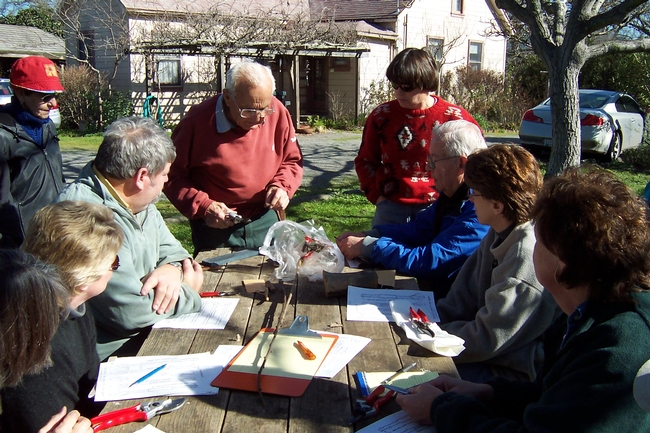
Last year I ordered grafted eggplant and bell pepper seedlings. I also bought the same non-grafted varieties locally and grew them all right next to each other.
This experience gave me some results that, while not scientific, I could measure.
The first year, I grew my four grafted tomatoes in a separate bed from the others. One fared poorly but the other three were tasty enough to merit saving seed.
For a number of years, I have been saving seed from the tomatoes that I like best. The tomatoes I grew from the seed that I saved from the grafted varieties did well last summer—as well as the grafted tomatoes had the year before. Since tomatoes are self-pollinating, their seeds come true—the offspring resemble the parent plant—unless the seeds come from hybrid tomatoes. In that case, the next generation may look more like an earlier ancestor than like the hybrid.
I was amazed by the rapid growth of the grafted ‘Rosa Blanca' eggplant. It had fruit prior to the non-grafted ‘Rosa Blanca'. However, after the initial rush, it sat there while the non-grafted plant grew taller and produced fruit. I had the same experience with the bell peppers. At the end of the season, the yield was almost the same.
For grafted vegetables, professional grafters choose rootstock that is resistant to virus and other soil-borne diseases. When seedlings are large enough, they are grafted onto the root material. It's a relatively simple procedure, and I was going to do it myself but the root material was only available in quantities of 100 or more. The rootstock seed, available online, is also pricy—about 50 cents per seed.
Vegetable grafting started in Japan in the 1920s, when a square watermelon was grafted onto rootstock for a round watermelon. I don't understand the advantage of a square watermelon except that it doesn't roll around. Korea and Japan have been grafting vegetables for almost a century, and the practice has now moved to Europe and the U.S.
Last summer, Sacramento Master Gardeners did an experiment, planting two 'Pineapple' tomatoes—one grafted, one not. I have grown this variety also. They concluded that the grafted plant had more problems than the one grown on its own roots, and it cost much more. In a recent issue, Organic Gardening magazine explored the benefits of grafted versus non-grafted tomatoes and concluded that grafted tomatoes did not offer any obvious advantages for the home gardener. That is my conclusion as well.
Based on my experience and my reading online, I believe that grafted vegetables are intended more for professional greenhouse growers. In that environment, crops are planted in soil that is reused repeatedly. As a result,viruses and other soil-borne diseases build up in the soil.
The home gardener can take precautions to avoid soil-borne diseases. The first line of defense is to rotate crops. Members of the nightshade family—tomatoes, potatoes, eggplant and peppers—should be planted in different areas each year.
Solarizing the soil in summer is another way to combat soil-borne disease. Wait for the summer heat to arrive, then clean up the targeted area, removing all plant material. Water well, thencover the area with clear plastic sheeting. Secure the edges andlet the soil bake. The soil under the plasticshouldreach about 140°F, hot enough to kill many soil-borne diseases. I also found that the heat kills invasive redwood roots.
Leave the plastic in place for about two months. For more information on solarizing, consult University of California sources online, such as: http://www.ipm.ucdavis.edu/PMG/PESTNOTES/pn74145.html
Since this is a drought year, I am planning to solarize several of my garden beds.
Workshop: Napa County Master Gardeners will lead a workshop on “Container Gardening and Succulents” on Saturday, May 17, from 9:30 a.m. to 11:30 a.m., at the Senior Multi-Use Center, 2185 Elliott Drive, American Canyon. Grow gardens that are mobile. Discover the best containers, soil and locations for your plants to prosper. Gain confidence to work with unfamiliar types of plants.Online registration (credit card only); Mail in registration (cash or check only).
Master Gardeners are volunteers who help the University of California reach the gardening public with home gardening information. Napa County Master Gardeners ( http://ucanr.org/ucmgnapa/) are available to answer gardening questions in person or by phone, Monday, Wednesday and Friday, 9 a.m. to Noon, at the U. C. Cooperative Extension office, 1710 Soscol Avenue, Suite 4, Napa, 707-253-4143, or from outside City of Napa toll-free at 877-279-3065. Or e-mail your garden questions by following the guidelines on our web site. Click on Napa, then on Have Garden Questions? Find us on Facebook under UC Master Gardeners of Napa County.
Napa County Master Gardeners welcome the public to visit their demonstration garden at Connolly Ranch on Thursdays, from 10:00 a.m. until noon, except the last Thursday of the month. Connolly Ranch is at 3141 Browns Valley Road at Thompson Avenue in Napa. Enter on Thompson Avenue.